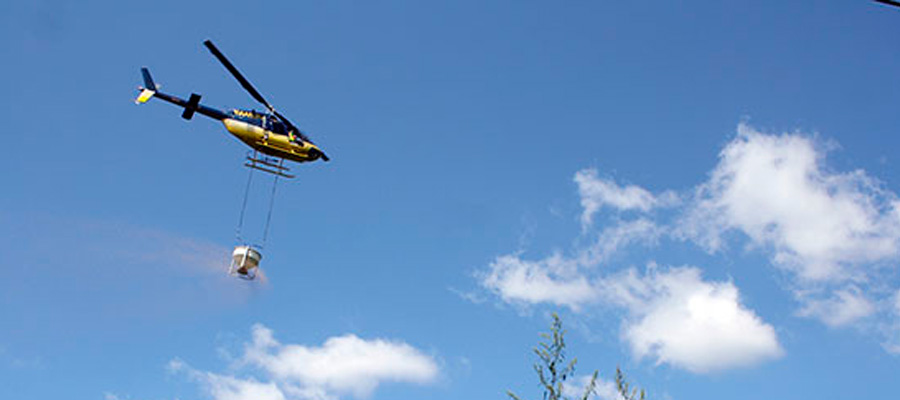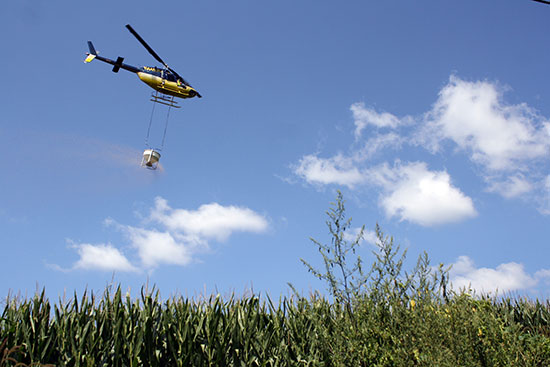USDA Tests Seeding Cover Crops With Helicopters
A new program designed to increase the use of cover crops on farms is being offered by the United States Department of Agriculture (USDA) Natural Resources Conservation Service (NRCS). This voluntary program allows farmers to establish cover crops from the air instead of conventional ground methods. On August 10, the newest effort will commence in Western Massachusetts, and move east across that State.
There are many benefits to a well established cover crop. As the term suggests, the purpose of a cover crop is to establish an actively growing crop between seasons or between primary crops in a rotation. Different covers provide different benefits to the soil and rotation.
The primary motivation for the NRCS to be supporting this practice is in the prevention of erosion. Whether by wind or water, having an actively growing crop across the field will slow or prevent soil loss from these weather related influences. From an agronomic standpoint, properly established cover crops can aid the production system by retaining nutrients, improving soil structure, reducing compaction, and even add to the nutrients in the soil.
In some cases, covers can be planted during the crop’s growing season, establishing itself as a companion crop with the actively growing crop; then once the crop is harvested, continue to grow through the fall before winter. In sustainable and organic systems, covers can be used as companion crops to reduce competition from weeds in the intended crop. The concept of a ‘living mulch’ involves the establishing a cover crop which is killed by natural or chemical means, and the following crop planted using no-till or zone-till into the residue left by the cover. This practice has many benefits, including soil conservation, but also has its own set of management challenges for success.
The primary advantages of using aerial seeding of covers include the ability to cover many acres quickly, and allowing for seeding into an actively growing crop at a stage when navigating across the field with a tractor is not possible. Aerial seeding also holds great potential when ‘frost seeding’ where you spread the seed on frozen ground in the late winter or early spring and take advantage of freezing and thawing at the surface to cover the seed.
Cover crop selection depends on the objectives. If the intent is to provide an organic form of nitrogen for the next crop, legumes should be the primary type of cover planted. Clovers, hairy vetch, and alfalfa are examples. Hairy vetch is a winter annual legume and is a great choice for living mulches as well. It establishes in the fall, and dies in the spring and summer. It is more expensive and a bit more tricky to grow, but research has suggested it fixes the greatest amount of nitrogen from any of the legumes.
If the intent is to provide the greatest protection against erosion, like on sloping fields or in strip cropped systems, farmers should look to crops that establish themselves quickly. This might include winter rye or winter wheat planted in September after chopping corn for silage, for example. The crop can then either be allowed to persist into the next summer for a harvested crop, or plowed down in the spring. When considering these crops as a plowdown, the organic nitrogen is tied up in the crop while growing, and is not released until well into the season. It also increases the Carbon:Nitrogen ratio in the soil. Using a readily available nitrogen source at planting is recommended in these situations, though only a small amount is needed to help the germinating crop (typically corn).
Another small grain that has potential as a cover crop is Spring Oats. Seeded in the fall, and given enough time to establish itself, it could be seeded with clover or another legume. The oats are killed over winter, and lay down to protect the soil while the legume continues to establish itself in the spring.
Aside from using planes and helicopters, a new technology being explored involves the use of Drones… there could be good potential with this method because of the ability to be more precise with placement of the seed. Work is underway in Japan to develop this technology further.
For more information on using cover crops on your farm, consult with your local Cooperative Extension agent, agricultural advisor, seed company representative, or consulting service in your area.
If you liked this article, please help us share the word on Facebook
To know more:
https://modernfarmer.com/2016/08/usda-cover-crop-helicopter/
https://harvestpublicmedia.org/article/can-oats-improve-bottom-lines-corn-belt
https://www.nrcs.usda.gov/wps/portal/nrcs/detail/ma/newsroom/releases/?cid=NRCSEPRD1227417




